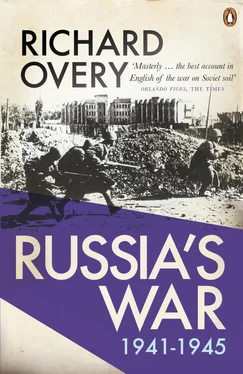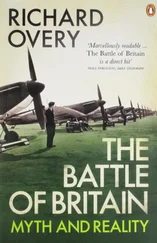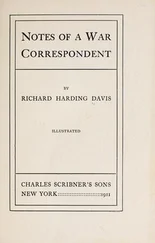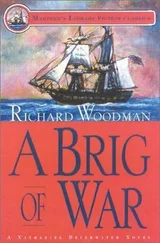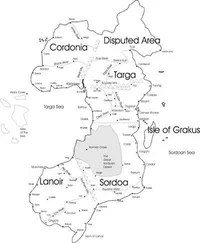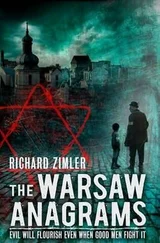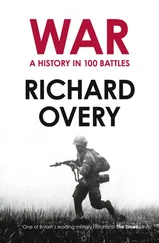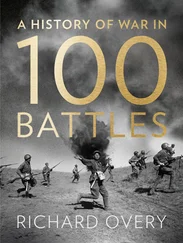Richard Overy - Russia's War
Здесь есть возможность читать онлайн «Richard Overy - Russia's War» — ознакомительный отрывок электронной книги совершенно бесплатно, а после прочтения отрывка купить полную версию. В некоторых случаях можно слушать аудио, скачать через торрент в формате fb2 и присутствует краткое содержание. Город: London, Год выпуска: 1999, ISBN: 1999, Издательство: Penguin Books Ltd, Жанр: military_history, на английском языке. Описание произведения, (предисловие) а так же отзывы посетителей доступны на портале библиотеки ЛибКат.
- Название:Russia's War
- Автор:
- Издательство:Penguin Books Ltd
- Жанр:
- Год:1999
- Город:London
- ISBN:978-0-14-192512-7
- Рейтинг книги:4 / 5. Голосов: 1
-
Избранное:Добавить в избранное
- Отзывы:
-
Ваша оценка:
- 80
- 1
- 2
- 3
- 4
- 5
Russia's War: краткое содержание, описание и аннотация
Предлагаем к чтению аннотацию, описание, краткое содержание или предисловие (зависит от того, что написал сам автор книги «Russia's War»). Если вы не нашли необходимую информацию о книге — напишите в комментариях, мы постараемся отыскать её.
[Contain tables. Best viewed with CoolReader.]
Russia's War — читать онлайн ознакомительный отрывок
Ниже представлен текст книги, разбитый по страницам. Система сохранения места последней прочитанной страницы, позволяет с удобством читать онлайн бесплатно книгу «Russia's War», без необходимости каждый раз заново искать на чём Вы остановились. Поставьте закладку, и сможете в любой момент перейти на страницу, на которой закончили чтение.
Интервал:
Закладка:
It was no accident that such a description almost perfectly matched the German attack launched on the Soviet Union thirteen years later. Tukhachevsky was a firm advocate of military westernization. The Future War owed not a little to a burgeoning programme of military collaboration in the 1920s between two most unlikely partners, the Red Army and the German Reichswehr. Links were first established between them in 1921. In August 1922 a firm agreement on military co-operation was signed, with a second and more extensive programme agreed to in March 1926 in Berlin. They were drawn together by their shared status as international pariahs in the early 1920s, the Soviet Union for its Communism, Germany for its alleged responsibility for the war of 1914. 15Each had something the other badly wanted: the Soviet Union wanted access to advanced military technology and military thinking; Germany needed somewhere to develop the weapons and tactical experience it was denied under the disarmament terms of the Treaty of Versailles.
So it was that German officers, who were separated from their Communist collaborators by a yawning ideological chasm, found themselves operating together in secret three major military installations and a handful of industrial enterprises. At the spa town of Lipetsk, 300 miles south-west of Moscow, an airfield was set up where German pilots were trained and new aircraft were put through their paces. At Kama on the Volga a tank school was founded, where German soldiers first tried out the ideas that bore rich fruit in 1939. At Tomka a chemical warfare centre was built, where Soviet observers watched the German staff experiment with gas attack and gas protection. The entire collaboration was kept as secret as possible. Trainees travelled to the Soviet Union on false passports, in civilian dress. Those that died in training accidents were put in coffins in large crates described as ‘aircraft parts’, and shipped by sea back to the Baltic port of Stettin. 16There also existed a more public exchange. Red Army officers were invited to German manoeuvres from 1925 on. Under Tukhachevsky’s guidance Soviet military leaders spent months or years in Germany absorbing German strategic thinking, German tactical doctrine and German ideas on the military economy and logistical support. In 1931 German officers were sent to Moscow on training courses. The roll-call of Germans involved in the exchanges included names that became famous a decade later – Model, Brauchitsch, Keitel, Manstein, Guderian. But a decade later almost all their Red Army counterparts were dead. 17
The lessons Tukhachevsky drew from the German side were central to the conception of modern war that emerged from the modernization of Red forces in the late 1920s. The primacy of the offensive became dogma. Revolutionary spirit may have been its justification, but the idea drew its real rationale from the nature of modern military technology – primarily the tank and the airplane. Tukhachevsky assumed that an offensive force, using these in combination and in large quantities, could, once it was mobilized, power forward at speed, penetrate the enemy lines of defence and then envelop the main enemy force in large, sweeping operations. 18The concept of ‘deep operations’, so very different from the static trench warfare and the primacy of the machine-gun in the Great War, was bound up with modernity. The armed forces Tukhachevsky inherited were almost all horse-drawn; mobility was more likely to be supplied by a bicycle than a truck. The equipment was obsolete and badly made. He recognized that the offensive strategy could work only in the context of a more general modernization of Soviet society. He accepted the views of his German acquaintances that modern war meant total war, the mobilization of economic resources as a fundament for successful military campaigns. The Soviet Union lacked those resources. There thus existed a profound gap between the operational plans for the fast-moving armoured offensive and the reality of economic underdevelopment, which could be bridged only by a radical transformation of the Soviet economy.
Tukhachevsky’s proposals for a military revolution were premature. His plans for aircraft and tank production were dismissed as quite unrealistic. His independent mind and authoritarian leadership earned him political enemies. In 1928 Stalin and Voroshilov had him removed as chief of staff. But in 1930, from a more modest post in Leningrad, Tukhachevsky forwarded a memorandum to the Kremlin, pressing the case for 40,000 aircraft and 50,000 tanks. Stalin accused him of ‘Red militarism’ and hinted that the idea smacked of economic ruin and counter-revolutionary sabotage. 19Nonetheless the core of Tukhachevsky’s reforms survived. By the early 1930s the Military Council and the General Staff had rejected any idea of defence in depth as an answer to Soviet backwardness. Under the guiding hand of Tukhachevsky’s successor, the former Tsarist staff officer Boris Shaposhnikov, a strategy was elaborated which remained in force until its weaknesses were abruptly exposed in 1941. Future war was deemed to be a two-stage affair. The preliminaries would be fought out at or near the frontier by strong covering forces operating behind fixed fortified areas, while the slow process of mobilizing the mass peasant-worker army went on at a prudent distance from the front until it was ready to rain shattering blows on the enemy on the other side of the border. The mass offensive had more of the steamroller about it than Tukhachevsky’s fast-moving juggernaut, but the shape of the strategy was not dissimilar. The difference lay with the idea of ‘deep operations’. A powerful mobile strike force able to manoeuvre at will in the rear of the enemy line was regarded as incompatible with the current state of industrial development and the largely peasant soldiery at the army’s disposal. The reforms of Frunze and Tukhachevsky supplied a more professional armed force. Standards of training and equipment were raised. The officers were given a status more consistent with their function. But the force was still primitively armed and poorly supplied, with an unsatisfactory level of morale. 20
After ten years the Soviet state was little more secure than it had been at the end of the civil war. In 1927 there developed a war scare more alarming than anything Soviet leaders had seen since 1919, when forces from more than a dozen countries fought briefly side by side with the counter-revolutionaries. The war scare had a number of separate components, each by itself only mildly threatening but in combination full of menace. In late May in London the Soviet trade delegation was closed down following pressure from the ‘Clear Out the Reds’ campaign, organized by a group of Conservative Members of Parliament. The British Government broke off diplomatic relations. 21In April the Soviet mission to China was closed down, and Chinese nationalists launched a bloody campaign against the Chinese Communists. In June the Soviet chargé d’affaires in Warsaw was assassinated. That month in Pravda Stalin announced that there was now ‘the real and actual threat of a new war’, though none came. The whiff of imperialist conspiracy begged for scapegoats. In May, twenty former Tsarist nobles who worked in government offices were arrested. On the day following the Warsaw assassination they were all executed without trial. Over the following weeks war-scare fever gripped Moscow. 22
A few months later the Soviet Union embarked on a programme of large-scale industrialization, the first step in what came to be seen as a ‘Second Revolution’. The timing perhaps owed something to the war scare or to the pressures to modernize the armed forces, but ultimately the industrial drive was brought about by the growing recognition among the Party faithful that their revolution was stumbling over the reality of a society largely composed of peasants, craftsmen and petty traders. At the end of the civil war little could be done to reverse the social reality of old Russia. In 1921 Lenin introduced the ‘New Economic Policy’, which permitted private trade and private ownership of land, and the grip on economic life held during the war loosened. By 1927 industrial output was back to approximately the levels of the pre-war Tsarist state, but the proletariat, in whose name the revolution to create a workers’ state had been launched, was small, impoverished and socially isolated. Among the vast mass of the Soviet peasantry fewer than 0.7 per cent of households boasted a Communist Party member. The apparatus of state and industry relied on large numbers of what came to be called ‘bourgeois experts’, whose enthusiasm for the new regime was believed to be muted.
Читать дальшеИнтервал:
Закладка:
Похожие книги на «Russia's War»
Представляем Вашему вниманию похожие книги на «Russia's War» списком для выбора. Мы отобрали схожую по названию и смыслу литературу в надежде предоставить читателям больше вариантов отыскать новые, интересные, ещё непрочитанные произведения.
Обсуждение, отзывы о книге «Russia's War» и просто собственные мнения читателей. Оставьте ваши комментарии, напишите, что Вы думаете о произведении, его смысле или главных героях. Укажите что конкретно понравилось, а что нет, и почему Вы так считаете.
